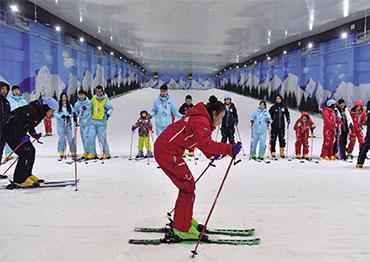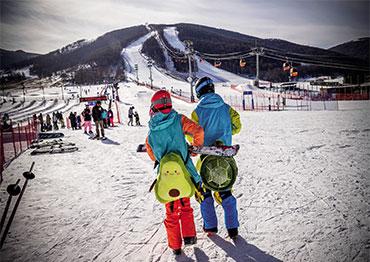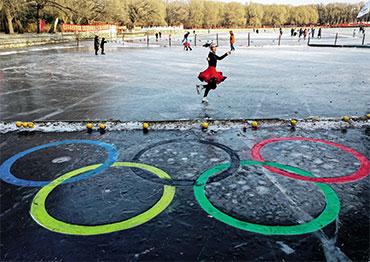Unlike ice sports, where children are the main force, skiing attracts mostly young adults. Li Yuan said during the snow sea son, a post in lifestyle app Little Red Book looking for people to carpool to Chongli ski resort, one of the most popular recreational ski venues near Beijing, gets seven or eight replies from strangers within half an hour.
“There are so many skiers in Beijing now, so it’s easy to find companions whenever I go to Chongli,” Li Yuan said. She feels that skiing is particularly soothing and not only provides a sense of conquering nature but also a feeling of freedom. It also gives young people in their 20s and 30s a way to make new friends.
Wen Mengying, deputy director of training at Chongli Fulong Mountain Sports Institute, was a professional skier 10 years ago. She feels that before Beijing and Zhangjiakou, a city in Hebei Province northwest of the capital, bid for the Winter Olympics in 2013, the majority of the public had no concept of recreational skiing and believed that it was only a competitive sport. The most famous ski resorts in China were far in the north,including Yabuli Ski Resort in Heilongjiang Province, which in 1996 hosted the Winter Asian Games.
In 2015, the first snow season after the Olympic bid, nearly 2.5 million people went skiing in Zhangjiakou’s resorts, an increase of 31 percent year-on-year, and 450,000 of them went skiing in Chongli, an significant increase of 42.3 percent year-on-year.
The number of snow resorts around Beijing increased from 22 before the Winter Olympics bid to 32. In order to meet growing demand, many resorts in Beijing upgraded their facilities in 2021. For example, Jiayuguan Snow Resort widened the piste and restored the advanced run to a length of 600 meters. Nanshan Ski Resort increased its investment in night skiing and increased the number of night skiing trails from 10 to 17.
Completed in 2016, Fulong Four Seasons Town in Chongli sought to attract casual skiers and tourists. Cui Yajie, director of Chongli Fulong Mountain Sports Institute, told NewsChina that Fulong aims to be “goodlooking, fun and cultural.” Their guests are mainly families and people between 20 and 35. Different from the systematic training of indoor ice training institutions, snow sports “have different development modes among the public,” according to Cui, meaning they are more for recreational purposes, or perhaps to find that perfect influencer photo.
Wu Bin, author of the White Paper on China’s Ski Industry and vice chairman of Beijing Ski Association, calls China’s ski market “the largest primary ski market in the world.”
According to the white paper, there were only 50 ski resorts in China in 2000, but by 2019 it had soared to 770. The number of recreational skiers increased from 10.3 million in 2014 to 20.76 million in 2021. Nearly 60 percent live in first-tier cities and 43.3 percent of skiers earn over 10,000 yuan (US$1,572) a month.
Hou Minghui, secretary-general of the Beijing Skating Association, said the expansion of the middle class and higher disposable income contributed to the popularity of winter sports.
Still, winter sports are not cheap. Xiao Yuhong estimated it costs 30,000-40,000 yuan (US$4,713-6,284) a year for a child to train in figure skating, and the protective gear for ice hockey is more expensive, around 50,000-60,000 yuan (US$7,855-9,432) a year. It costs more if they want to pursue a professional career.
The increased accessibility of winter sports has spurred upgrades across the industry. According to the China Ice and Snow Tourism Development Report (2022) released by the China Tourism Academy, the number of winter sport tourists in China is expected to reach 305 million from 2021 to 2022, with revenues expected to hit 323.3 billion yuan (US$50.1b).
According to sales data from e-commerce site JD.com, orders for snow clothing, snowboards, ski goggles and other winter sport equipment all showed explosive growth during the platform’s Single’s Day “Double 11” shopping event in November 2021.
Meanwhile, Chinese brands are heading overseas. According to AliExpress, a cross border e-commerce platform owned by Alibaba Group, sales of Chinese ski products increased by over 60 percent in the fourth quarter of 2021 compared with 2020. In 2021, consumers from 100 countries and regions around the world bought Chinesemade snow gear on AliExpress. The number of winter sport enterprises has quadrupled from 2014 to 2020.
Sarah Lewis, secretary-general of the International Ski Federation for 20 years, told the Xinhua News Agency in 2021 that the plan of “engaging 300 million people in ice-snow sports” will affect winter sports markets worldwide as more people take part.
China certainly hopes that its snow and ice sports industries can ride on the success of its athletes, who have scored their best-ever Winter Games medal tally this year. Industry insiders eagerly await to see if winter sports can tempt more people to try them out, and escape its so-far niche appeal post-Games.

 Old Version
Old Version



